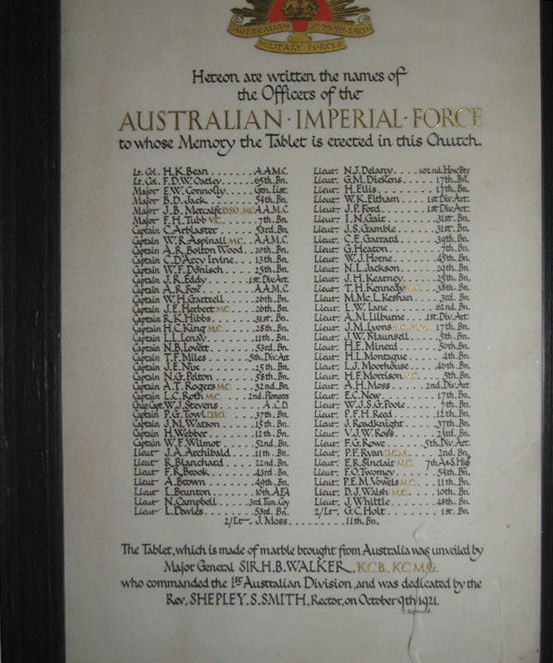Name
John Maher Lyons
1887
Conflict
First World War
Date of Death / Age
09/10/1917
Rank, Service Number & Service Details
Lieutenant
605
Australian Infantry, A.I.F.
17th Bn.
Awards: Service Medals/Honour Awards
1914 /15 Star, British War and Victory medals
M C, M M, M S M
Cemetery/Memorial: Name/Reference/Country
YPRES (MENIN GATE) MEMORIAL
Panel 17
Belgium
Headstone Inscription
N/A
UK & Other Memorials
Digswell House Australian Hospital Memorial, St John's Church, Digswell
Pre War
John Maher (Jack) Lyons was born 1887 in Emmaville, New South Wales, the son of Patrick and Cecilia Lyons.
He was educated at St Carthage's School, Lismore, New South Wales. He lived at Ellerslie, Strachan Street, South Kensington, New South Wales with his wife Evelyn and worked as a tram conductor.
Wartime Service
He enlisted in the Australian Naval and Military Expeditionary Force (ANMEF) on 16 August 1914 and served as a Private with 1st (Tropical) Battalion, leaving on HMAT A35 Berrima on 19 August 1914.
After a brief period of training at Palm Island, the force invaded New Britain on 11 September. After short but fierce fighting, the Union Jack was raised over Rabaul on 13 September. His enlistment term with the ANMEF having expired he returned to Australia and enlisted in the AIF on 1 February 1915 as a Corporal with the 17th Battalion, B Company. His unit embarked from Sydney, NSW on HMAT A32 Themistocles on 12 May 1915, initially going to Egypt, then arriving at Gallipoli on 20 August. He took part took part in the battle for Hill 60 and was promoted to the rank of Sergeant in September for his outstanding leadership. He left Gallipoli during the evacuation in December and returned to Egypt.
The battalion shipped to France in March 1916. During the battalion's initial fighting in the Nursery Sector of the Western Front, he took part in a trench raid conducted by members of the 5th Infantry Brigade during the night of 26/27 June and in the fighting at Pozieres in July of 1916. He was awarded the Military Medal for his actions during this battle and for his work during the fighting for Hill 60 at Gallipoli. The recommendation reads
"During the attack on Hill 60, Gallipoli, he showed great coolness and presence of mind under fire, attention being drawn to this fact by officers outside the Battalion. At Quinn's Post as Sgt. In charge of bombers, he proved very efficient and intrepid. His work in France has also been excellent."
He suffered a gunshot wound to the left side of his face on 26 July and was evacuated to England. He returned to France in October and was awarded the Meritorious Service Medal on 1 January 1917 for his efforts during the fighting in 1916.
He was wounded a second time near Grevilliers on 3 March 1917 when he was hit by shrapnel in his legs, buttocks and right wrist. He was evacuated back to England for operations to remove the shrapnel and to recover. Lyons returned to the battalion on 31 July and was promoted to Lieutenant the same day.
Lyons was awarded a posthumous Military Cross for his actions at Passchendaele on 9 October 1917,
"For conspicuous gallantry and devotion to duty in an attack. Despite a heavy barrage, darkness, and mud, he got his men to their allotted positions on the jumping off tape with very few casualties. He led forward the first wave, and when all his platoon had become casualties collected spare men and consolidated a gap in the line. He captured fourteen prisoners and three machine guns."
Source: 'Commonwealth Gazette' No. 137
Date: 30 August 1918
He was wounded during the attack and placed on a stretcher in a captured German pill box. Due to a heavy counter attack, Australian troops were forced to retreat and he couldn't be moved. The area was later retaken, but he was not found. He has no known grave and is commemorated on the Menin Gate Memorial at Ypres.
Acknowledgments
Brenda Palmer
aif.adfa.edu.au., The Australian War Memorial



